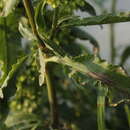Comments
provided by eFloras
Rumex pseudonatronatus often is confused with R. longifolius and R. crispus.
- license
- cc-by-nc-sa-3.0
- copyright
- Missouri Botanical Garden, 4344 Shaw Boulevard, St. Louis, MO, 63110 USA
Description
provided by eFloras
Herbs perennial. Roots vertical, large, 1-2 cm in diam. Stems erect, 80-120 cm tall, simple or branched above, grooved, glabrous. Basal leaves lanceolate or narrowly lanceolate, sometimes lanceolate-linear, 15-30 × 1.5-4 cm, abaxially minutely papillate along veins, adaxially glabrous, base cuneate to narrowly cuneate, margin crisped or undulate, apex acute; cauline leaves shortly petiolate, narrowly lanceolate, small; ocrea fugacious, white, thinly membranous. Inflorescence paniculate, dense in distal part, sometimes interupted at base, 20-40 cm, narrow. Flowers bisexual. Pedicels slender, articulate below middle, articulation swollen in fruit. Inner tepals enlarged in fruit; valves nearly orbicular or orbicular-cordate, 3.5-4.5 mm, all without tubercles, sometimes 1 valve with 1 indistinct tubercle less than 1-1.3 mm, conspicuously net veined, base slightly cordate, margin entire or weakly erose, apex obtuse. Achenes brown, shiny, narrowly ovoid, trigonous, 2-2.5 mm. Fl. Jun-Jul, fr. Jul-Aug. 2n = 40.
- license
- cc-by-nc-sa-3.0
- copyright
- Missouri Botanical Garden, 4344 Shaw Boulevard, St. Louis, MO, 63110 USA
Description
provided by eFloras
Plants perennial, glabrous or very indistinctly papillose normally only on branches of inflorescences, or on veins of leaf blades abaxially, with fusiform, vertical rootstock. Stems erect, branched from above middle, 50-120(-150) cm. Leaves: ocrea deciduous or partially persistent at maturity; blade lanceolate to narrowly lanceolate or lanceolate-linear, normally 15-30 × 1-4 cm, apex acute. Inflorescences terminal, occupying distal 1/ 2 of stem, normally dense in distal part and interrupted at base, narrowly paniculate, branches usually straight or slightly arcuate. Pedicels articulated in proximal 1/3, filiform, 4-9 mm, articulation distinctly swollen. Flowers 15-25 in whorls, inner tepals orbiculate, ovate-orbiculate, or indistinctly reniform, 3.5-5(-6) × 3-5 mm, base slightly cordate, margins entire or rarely subentire to very weakly erose, undulate or nearly flat, apex obtuse or rounded, occasionally subacute; tubercles normally absent, sometimes with 1 indistinct tubercle or slightly thickened midvein less than 1-1.3 mm wide, normally less than 2 times as wide as inner tepals. Achenes usually reddish brown, 2-2.5 × 1-1.5 mm. 2n = 40.
- license
- cc-by-nc-sa-3.0
- copyright
- Missouri Botanical Garden, 4344 Shaw Boulevard, St. Louis, MO, 63110 USA
Distribution
provided by eFloras
Gansu, Hebei, Heilongjiang, Jilin, Qinghai, Shaanxi, Xinjiang [Kazakhstan, Kyrgyzstan, Mongolia, Russia; Europe; locally naturalized in North America].
- license
- cc-by-nc-sa-3.0
- copyright
- Missouri Botanical Garden, 4344 Shaw Boulevard, St. Louis, MO, 63110 USA
Distribution
provided by eFloras
introduced; Alta., B.C., Man., Ont., Sask., Yukon; Minn., N.Dak., S.Dak.; e Europe; c Asia (Siberia).
- license
- cc-by-nc-sa-3.0
- copyright
- Missouri Botanical Garden, 4344 Shaw Boulevard, St. Louis, MO, 63110 USA
Flowering/Fruiting
provided by eFloras
Flowering late spring-summer.
- license
- cc-by-nc-sa-3.0
- copyright
- Missouri Botanical Garden, 4344 Shaw Boulevard, St. Louis, MO, 63110 USA
Habitat
provided by eFloras
Forest margins on mountain slopes, moist valleys; 300-3200 m.
- license
- cc-by-nc-sa-3.0
- copyright
- Missouri Botanical Garden, 4344 Shaw Boulevard, St. Louis, MO, 63110 USA
Habitat
provided by eFloras
Ruderal and alluvial habitats, slightly saline soil, waste places, roadsides, shores of rivers and lakes, meadows, cultivated fields; 10-1000m.
- license
- cc-by-nc-sa-3.0
- copyright
- Missouri Botanical Garden, 4344 Shaw Boulevard, St. Louis, MO, 63110 USA
Synonym
provided by eFloras
Rumex domesticus C. Hartman var. pseudonatronatus Borbás, Ertek. Term. Koreb. Mag. Tud. Acad. 11(18): 21. 1880.
- license
- cc-by-nc-sa-3.0
- copyright
- Missouri Botanical Garden, 4344 Shaw Boulevard, St. Louis, MO, 63110 USA
Synonym
provided by eFloras
Rumex domesticus Hartman var. pseudonatronatus Borbás, Értek. Term. Köréb. Magyar Tud. Akad. 11: 21. 1880; R. fennicus (Murbeck) Murbeck; R. pseudonatronatus subsp. fennicus Murbeck
- license
- cc-by-nc-sa-3.0
- copyright
- Missouri Botanical Garden, 4344 Shaw Boulevard, St. Louis, MO, 63110 USA
Rumex pseudonatronatus
provided by wikipedia EN
Rumex pseudonatronatus, common name field dock[3] or Finnish dock, is a plant species native to northern Europe and northern Asia, known from Asiatic and European Russia, China, Mongolia, Kazakhstan, Kyrgyzstan, Finland, Norway, Sweden, Belgium, Netherlands, Estonia, Latvia, Lithuania, Poland, Belarus, etc. It is naturalized in much of Canada and to the north-central United States. It is known from every Canadian province from Québec to British Columbia, plus Yukon, North Dakota, South Dakota and Minnesota. It grows in wet and/ore disturbed sites along stream banks, lake shores, roadsides, ditches, cultivated fields, meadows, etc.[4][5][6][7]
Rumex pseudonatronatus is a perennial herb. Stems are erect, up to 150 cm tall, often branching above the middle. Leaves are lanceolate, up to 30 cm long. The inflorescence typically takes up the upper half of the shoot, the flowers green, pink or red, in whorls of up to 30 flowers. Achenes are reddish-brown, up to 3 mm long.[4][8][9]
References

- license
- cc-by-sa-3.0
- copyright
- Wikipedia authors and editors
Rumex pseudonatronatus: Brief Summary
provided by wikipedia EN
Rumex pseudonatronatus, common name field dock or Finnish dock, is a plant species native to northern Europe and northern Asia, known from Asiatic and European Russia, China, Mongolia, Kazakhstan, Kyrgyzstan, Finland, Norway, Sweden, Belgium, Netherlands, Estonia, Latvia, Lithuania, Poland, Belarus, etc. It is naturalized in much of Canada and to the north-central United States. It is known from every Canadian province from Québec to British Columbia, plus Yukon, North Dakota, South Dakota and Minnesota. It grows in wet and/ore disturbed sites along stream banks, lake shores, roadsides, ditches, cultivated fields, meadows, etc.
Rumex pseudonatronatus is a perennial herb. Stems are erect, up to 150 cm tall, often branching above the middle. Leaves are lanceolate, up to 30 cm long. The inflorescence typically takes up the upper half of the shoot, the flowers green, pink or red, in whorls of up to 30 flowers. Achenes are reddish-brown, up to 3 mm long.
- license
- cc-by-sa-3.0
- copyright
- Wikipedia authors and editors

